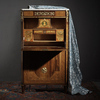A Gustavian secretaire by Georg Haupt, master in Stockholm 1770-1784.
Not signed. Several different veneers, gilt brass mounts, white marble top. With well preserved inlays. Length 79, width 41, height 136,5 cm.
The marble top with repair, one brass mount missing on inside of leg.
Provenance
According to family tradition commissioned by the silk manufacturer Johan Christian Schönherr as a gift to his wife Lovisa on the occasion of of their son's birth in 1772. Johan Christian Schönherr , silk manufacturer in Stockholm. Born in 1736 in Saxony , Germany , died in Stockholm in 1783. Married in 1769 with Lovisa Christina Herman. Born in 1745 in Amsberg , died in Stockholm in 1819. The estate inventory after Lovisa Schönherr 1820 included a " veneered Chiffonie with gray top " to the relatively high amount of 20 crowns. The secretaire has been inherited in the same family since its creation until the present owner. The buyer can be given complete provenance .
Exhibitions
Exhibited at the Royal palace in Stockholm at the Georg Haupt exhibition on the occasion of the Swedish King Carl XVI Gustaf's sixties anniversary (Kungliga Husgerådskammarens Hauptutställning 2006, catalogue number 64).
Literature
Böttiger, John, Svenska Slöjdföreningens Tidskrift, årgång 14, 1918, första häftet, sid 2-6.
Lagerquist, Marshall, Georg Haupt Ebeniste du Roi, Nordiska museets handlingar nr 92, 1979, page 148-149.
Ljungström, Lars, Georg Haupt, Gustav III:s hovschatullmakare, Kungl. Husgerådskammaren, Stockholm 2006, catalogue number 64, pages 144, 60 and 84.
More information
According to family tradition commissioned by the silk manufacturer Johan Christian Schönherr as a gift to his wife Lovisa on the occasion of of their son's birth in 1772.
The secretaire is masterfully executed by the royal cabinet maker Georg Haupt. Thanks to the well preserved condition of the secretaire we can get a feel for what Lovisa Schönherr felt when she opened the writing flap and saw the beautifully colored inlays. Exclusive furniture in the 1700s were usually commissioned by a private individual who had a specific purpose with the furniture. Its design and decor would reflect the user's position and ambitions of the community. Furniture for women was decorated with love attributes and portraits of women, while the man's furniture were adorned with the attributes of different professions and symbols of power. The neat size and the inlayed female portrait medallion behind the writing flap shows that the secretaire was meant for a woman. Even if the women in the 1700s were often limited to the private family sphere, she could as a widow get a big financial responsibility. Many shops and businesses were continued by widows. This happened even Lovisa Schönherr when she lost her husband at the age of 38. When her son Carl Johan turned 19 years, mother and son ran the silk factory in partnership under the name “Lovisa Christina Schönherr & Son”. The factory, which was situated at Götgatan 51 in Stockholm, included 72 looms and 200 workers. In the beginning of the 19th century Carl Johan left the silk factory and moved to the manor Sparresäter northeast of Skara, where he became a prominent entomologists. The secretaire has since its creation been inherited within the same family up to the autumn sale at Bukowskis. The secretaire has always been accompanied by a pastel portrait of Lovisa Schönherr (the portrait is not included in the sale).

































































































